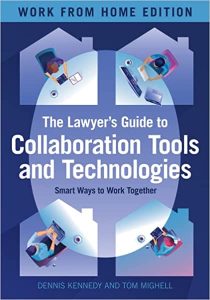Book Review: Dennis M Kennedy, Thomas L Mighell, The Lawyer’s Guide to Collaboration Tools and Technologies: Smart Ways to Work Together, Work From Home Edition (ABA 2022). Available from Amazon or direct from the publisher.

Is The Lawyer’s Guide to Collaboration Tools and Technologies: Smart Ways to Work Together the most important legal technology book to come out in the past year? There’s no better candidate in my mind. It may in fact be the most useful legal tech book to come out since 2018—which is when the authors published the previous edition.
Collaboration tools are the most important current development in legal technology and are likely to increase in importance for the foreseeable future. Did legal technology really advance 10 years in 10 months during the pandemic, as the cliché would have it? Nope, but we are never going back to 2019.
This latest tome from Dennis Kennedy and Tom Mighell is the third edition in one of my favorite American Bar Association series. It’s a substantial re-write of the second edition, with the tagline “Work From Home Edition” added to the title. As far as I’m concerned, the pandemic-inspired tagline is not needed and it might even cause some potential buyers to underestimate this book’s value. The pandemic focused attention on teleworking, but collaboration means much more.
Some ideas are worth typographic emphasis, so let’s say it clearly and loudly: This is not a book about teleworking. It’s about collaboration anywhere, anytime, and how to harvest the potentially giant productivity gains that flow from working together better.
This is not just a book for lawyers and IT staffs. It’s relevant for law firm administrative staffs and many who work with lawyers, including “C-level” executives and their staffs, opposing counsel and their staffs, court personnel, judges and professionals in regulatory agencies, experts (medical, accounting, forensics, etc.), vendors, and, probably most importantly, clients. Especially your most lucrative clients, the ones you most want to retain.
One of the best features is that the authors deemphasize buying new hardware or software. They emphasize getting the most from the hardware and software you already own. Why spend hundreds, thousands, or tens of thousands of dollars on specialized collaboration software—which may not be compatible with that used by your potential collaboration partners—when you and they most likely already own a package like Microsoft 365, which now includes your standard Office programs, as well as Microsoft Teams, planning and scheduling tools and much more?
This book convincingly makes the case that the future is now. Clients who are used to collaborating with doctors and other businesses through tools like web portals (what we used to call extranets) are beginning to wonder why their lawyers are not as easy to work with. Client-driven change can be the most dangerous.
We sometimes talk about apps like Facebook as “sticky,” meaning they are difficult for users to leave. Providing key clients with collaboration services that improve quality of service and reduce expenses may be the ultimate way to make your law practice “sticky.” Make it hard for your best clients to leave you.
I particularly love this book because it includes a key idea developed further in my upcoming book: the particular tools you use are less important than establishing the right culture of collaboration. While this book’s significance goes far beyond pandemic-inspired telework ideas, the legacy of Covid is relevant in one way. Mighell, channeling Winston Churchill, points out: “Never let a good crisis go to waste.” Inspired by the Covid crisis, savvy law firms, courts, and others have pivoted to permanently implementing better ways of doing business. We will not see many jury trials by Zoom, but today it’s hard to justify things like most in-person hearings, in-person depositions, and in-person court “motion days.” Things like digital signatures are now not avant-garde but basic.
Finally, just in case you are wondering: If you own the previous edition, is it worth buying this one?
No brainer. It’s the best way to spend $100 I can imagine for any lawyer looking to improve their bottom line. Any lawyer who wants to lead the way (or at least avoid being crushed by inevitable changes) needs this book.
Author’s Note: I posted some ideas about how to get the maximum benefit from this fine book at Newideaslegaltech.com.
